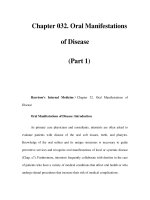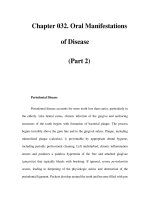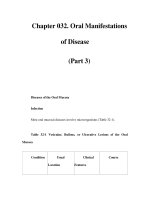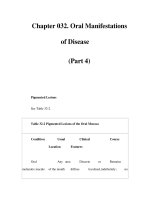Chapter 032. Oral Manifestations of Disease (Part 1) doc
Bạn đang xem bản rút gọn của tài liệu. Xem và tải ngay bản đầy đủ của tài liệu tại đây (13.43 KB, 5 trang )
Chapter 032. Oral Manifestations
of Disease
(Part 1)
Harrison's Internal Medicine > Chapter 32. Oral Manifestations of
Disease
Oral Manifestations of Disease: Introduction
As primary care physicians and consultants, internists are often asked to
evaluate patients with disease of the oral soft tissues, teeth, and pharynx.
Knowledge of the oral milieu and its unique structures is necessary to guide
preventive services and recognize oral manifestations of local or systemic disease
(Chap. e7). Furthermore, internists frequently collaborate with dentists in the care
of patients who have a variety of medical conditions that affect oral health or who
undergo dental procedures that increase their risk of medical complications.
Acknowledgment
The author acknowledges the contribution to this chapter by the previous
author, Dr. John S. Greenspan.
Diseases of the Teeth and Periodontal Structures
Tooth and Periodontal Structure
Tooth formation begins during the sixth week of embryonic life and
continues through the first 17 years of age. Tooth development begins in utero and
continues until after the tooth erupts. Normally all 20 deciduous teeth have erupted
by age 3 and have been shed by age 13. Permanent teeth, eventually totaling 32,
begin to erupt by age 6 and have completely erupted by age 14, though third
molars (wisdom teeth) may erupt later.
The erupted tooth consists of the visible crown covered with enamel and
the root submerged below the gum line and covered with bonelike cementum.
Dentin, a material that is denser than bone and exquisitely sensitive to pain, forms
the majority of the tooth substance. Dentin surrounds a core of myxomatous pulp
containing the vascular and nerve supply. The tooth is held firmly in the alveolar
socket by the periodontium, supporting structures that consist of the gingivae,
alveolar bone, cementum, and periodontal ligament. The periodontal ligament
tenaciously binds the tooth's cementum to the alveolar bone. Above this ligament
is a collar of attached gingiva just below the crown. A few millimeters of
unattached or free gingiva (1–3 mm) overlap the base of the crown, forming a
shallow sulcus along the gum-tooth margin.
Dental Caries, Pulpal and Periapical Disease, and Complications
Dental caries begin asymptomatically as a destructive process of the hard
surface of the tooth. Streptococcus mutans, principally, along with other bacteria
colonize the organic buffering film on the tooth surface to produce plaque. If not
removed by brushing or the natural cleaning action of saliva and oral soft tissues,
bacterial acids demineralize the enamel.
Fissures and pits on the occlusion surfaces are the most frequent sites of
decay. Surfaces adjacent to tooth restorations and exposed roots are also
vulnerable, particularly as teeth are retained in an aging population. Over time,
dental caries extend to the underlying dentin, leading to cavitation of the enamel
and ultimately penetration to the tooth pulp, producing acute pulpitis. At this early
stage, when the pulp infection is limited, the tooth becomes sensitive to percussion
and hot or cold, and pain resolves immediately when the irritating stimulus is
removed.
Should the infection spread throughout the pulp, irreversible pulpitis
occurs, leading to pulp necrosis. At this late stage pain is severe and has a sharp or
throbbing visceral quality that may be worse when the patient lies down. Once
pulp necrosis is complete, pain may be constant or intermittent, but cold sensitivity
is lost.
Treatment of caries involves removal of the softened and infected hard
tissue; sealing the exposed dentin; and restoration of the tooth structure with silver
amalgam, composite plastic, gold, or porcelain. Once irreversible pulpitis occurs,
root canal therapy is necessary, and the contents of the pulp chamber and root
canals are removed, followed by thorough cleaning, antisepsis, and filling with an
inert material. Alternatively, the tooth may be extracted.
Pulpal infection, if it does not egress through the decayed enamel, leads to
periapical abscess formation, which produces pain on chewing. If the infection is
mild and chronic, a periapical granuloma or eventually a periapical cyst forms,
either of which produces radiolucency at the root apex.
When unchecked, a periapical abscess can erode into the alveolar bone
producing osteomyelitis, penetrate and drain through the gingivae (parulis or
gumboil), or track along deep fascial planes, producing a virulent cellulitis
(Ludwig's angina) involving the submandibular space and floor of the mouth
(Chap. 157). Elderly patients, those with diabetes mellitus, and patients taking
glucocorticoids may experience little or no pain and fever as these complications
develop.









